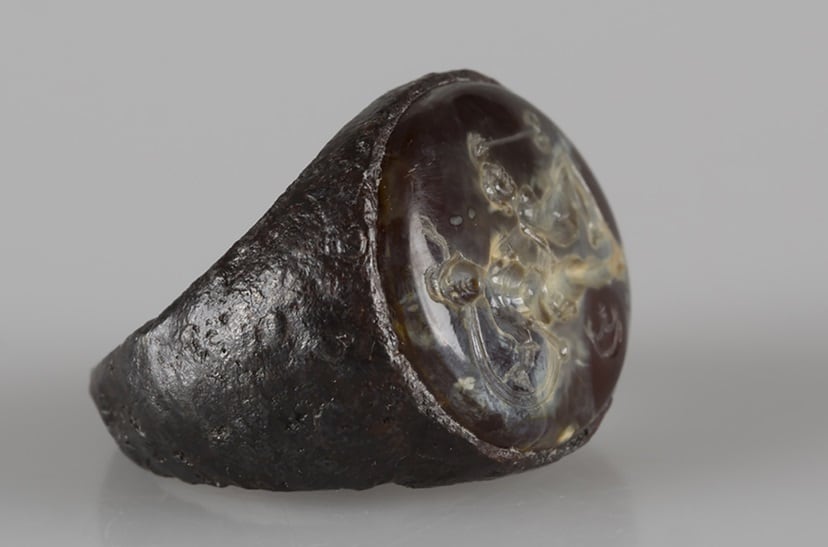Vidím špatně a nebo tam ta amazonská královna drží detektor?Studuje signál skrčená nad cívkou 
Beautiful Roman signet ring with Achilles and Penthesilea changes historians' views
Categories: Castles, strongholds and extinct places , Nálezy nejenom s detektorem v západní Evropě
At the archaeological site of Tossal de Baltarga in the Catalan Pyrenees, a Roman signet ring with a jewel and an engraving of Achilles holding the slain Amazonian queen Penthesilea was discovered. According to a recently published study in the European Journal of Archaeology, the ring and other finds are evidence that the highlands were much more important to the Romans than previously thought.
The ring is iron, with a deep-set gemstone. It has been dated to between 100 and 50 BC. The stone depicts a beautifully detailed engraving of Achilles in full armour with sword and shield, supporting the dying Penthesilea. The Amazon queen is kneeling with her head bowed, Achilles is holding her with his left hand with her head turned away. The perfect engraving with beautiful details is on a stone measuring only 17 x 15.5 mm.
This motif is often seen in Greco-Roman decorative art, based on Homericstory in which Achilles dealt a fatal blow to the amazon and, after removing her helmet, immediately fell in love with her. But she was already dead. According to some sources, Achilles then committed necrophilia. The traveller and geographer Pausanias, in his Description of Greece of 2. notes that on the throne of the monumental statue of the god Zeus at Olympia, there was supposed to be a relief of "Penthesileia being abandoned by her spirit and Achilles holding her in his arms as she died." A marble relief of the same scene from the sanctuary of Aphrodite of Aphrodisias still exists today.
The quality of the engraving is of such a high standard that it could not have been created by a local Iberian craftsman. It is also highly unlikely that such a ring would have been worn by any Iberian, even as a member of the local elite. It was a luxury import, the likes of which did not exist in Iberia before the Roman occupation. The ring must have been brought to Tossal de Baltarga by a Roman officer.
Iron signet rings were formerly found in association with late Republican legions at battle sites in Iberia. They were expensive items, but more often made of durable iron than precious metals. They served a practical and frequent purpose. They were commonly used to sign personal and official documents. They were also a kind of identification mark, a means of identifying a Roman officer killed in battle.
Three iron seals have been found in the Roman Republican layers of Tossal de Baltarga rings that date from three different phases from the Bronze Age until the abandonment of the city in the 1st century BC. The ring with Achilles and Penthesilea was discovered in 2017 in Building F, which was built in the middle of the 2nd century BC. and abandoned between 50 and 30 BC.
Rings, coins and other small artefacts found at the site refer to small military garrisons with watchtowers that may have playedplayed an important role in efforts to control the nearby Iberian Pass during the wars of the late Republican period, including Caesar's conquest of Gaul (58-50 BC). AD) and the revolt of Quina Sertoria (80-72 BC).
The scholars in that study therefore propose that the loss of the signet rings was linked to the abandonment of Tossal de Baltargas as a result of military campaigns in the mid-first century BC. The key role of the settlement as a major base in the area may have suggested that the garrison was withdrawn in haste. In such a scenario, the rings may have been unwittingly lost and the settlement abandoned as part of the major reconfiguration of the area following the suppression of the last rebellion of 39 BC.
Roman Nemec




Sources: thehistoryblog.com, cambridge.org
The article is included in categories:
- Archive of articles > Castles, strongholds and extinct places
- Archive of articles > Archaeology > Finds and rescue research abroad > Nálezy nejenom s detektorem v západní Evropě
Post
Ta rytina na tak malé ploše je neskutečně krásná a plastická 
MarkyMark: Díky za poučení,máš to krásně nastudované kolego,oni ty staré civilizace byly vskutku velmi vyspělé,jak vidno... 




